Apple Strudel (Apfelstrudel)
This post may contain affiliate links. See my disclosure policy.
One of the national dishes of Austria, Apfelstrudel (Apple Strudel) is a quintessential Austrian dessert featuring flaky pastry filled with apples and raisins and served with vanilla sauce or ice cream. Here is a traditional apple strudel recipe you can make in your own kitchen and imagine you’re in Vienna or the Austrian Alps with every delicious mouthful!
For more favorite Austrian treats be sure to try my Germknödel, Kaiserschmarrn, Vanillekipferl and Mozartkugeln!
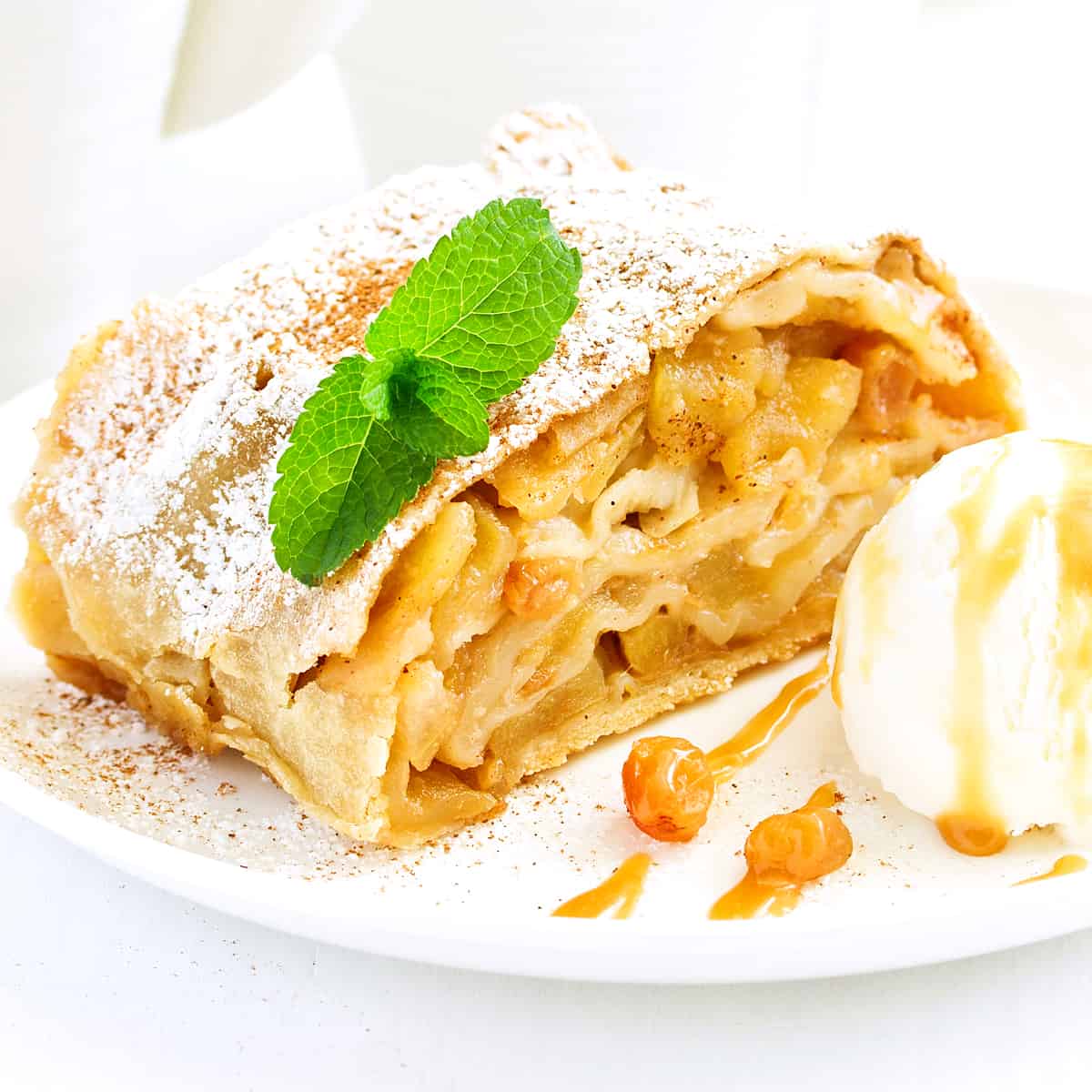
What is Apple Strudel?
Apple Strudel, or Apfelstrudel in German, is an oblong-shaped rolled pastry that’s filled with apples seasoned with cinnamon and sugar. Raisins are traditionally added and nuts are likewise common. Breadcrumbs are added either to the apple mixture or strewn onto the pastry shell before the filling is added in order to absorb excess liquid. Apfelstrudel is traditionally served with a dusting of powdered sugar and some vanilla sauce, vanilla ice cream, or whipped cream.
Apple strudel is a quintessential Austrian dessert, one of its national dishes, and you’ll find it served in cafes and restaurants throughout the country. It is likewise popular throughout Germany (where I grew up eating it), Hungary, and other Eastern European countries in different variations.
Apple strudel is made with unleavened pastry that’s rolled into very thin sheets. Traditionally, making the pastry shell is a long and complex process, made of many thin sheets of pastry dough, but most contemporary recipes opt for a single thin sheet and the apple filling is rolled inside of it. The name “strudel” is German for “whirlpool”, referring to the swirled appearance of the finished dessert.
Where Did Apfelstrudel Originate?
Apple strudel gained popularity in the 18th century during the Habsburg Empire and was popular throughout the Austro-Hungarian Empire. Though it’s most commonly associated with Austrian cuisine, some food historians believe it may have originated in Hungary and then spread to Austria, Germany, and other parts of the Austro-Hungarian empire. Food historians also note that Apfelstrudel was highly influenced by the Ottoman Turks with its multiple layers of thin sheets of pastry dough being reminiscent of phyllo pastry. Phyllo pastry was introduced to Austria in 1453 and that laid the framework for the birth of the strudel. Gradually strudels with different filling combinations came onto the scene, both sweet and savory (cherry, mixed berries, various fruits, poppy seeds, marzipan, spinach and feta, potato and onions, etc). The oldest strudel recipe is for a cream-filled strudel and the original 1696 handwritten copy can be found at the Wienbibliothek im Rathaus, the Viennese City Library.
I grew up in southern Germany (Baden-Württemberg) eating Apfelstrudel and my mom is from Bavaria where it is likewise popular. I’ve also had Apfelstrudel in Vienna, Salzburg, and in rural mountains of Austria. The Germans make it the same way as the Austrians and you can find excellent apple strudel throughout both countries. But there’s something about eating Apfelstrudel in Austria that makes the experience extra special.
We took a recent trip to Austria and visited Todd’s stepmom, Monika, and her parents. Always up for an adventure and passionate about her beautiful homeland, she took us to a variety of scenic sites, including some of the places Todd knew and loved from his childhood. One of our excursions was a hike up the Austrian Alps where we picked wild Preiselbeeren (lingonberries) to make jam, a traditional accompaniment for Schnitzel. Our hike ended at the mountaintop where, amidst those breathtaking views and mountain air, we enjoyed some traditional Austrian food, including Apfelstrudel.


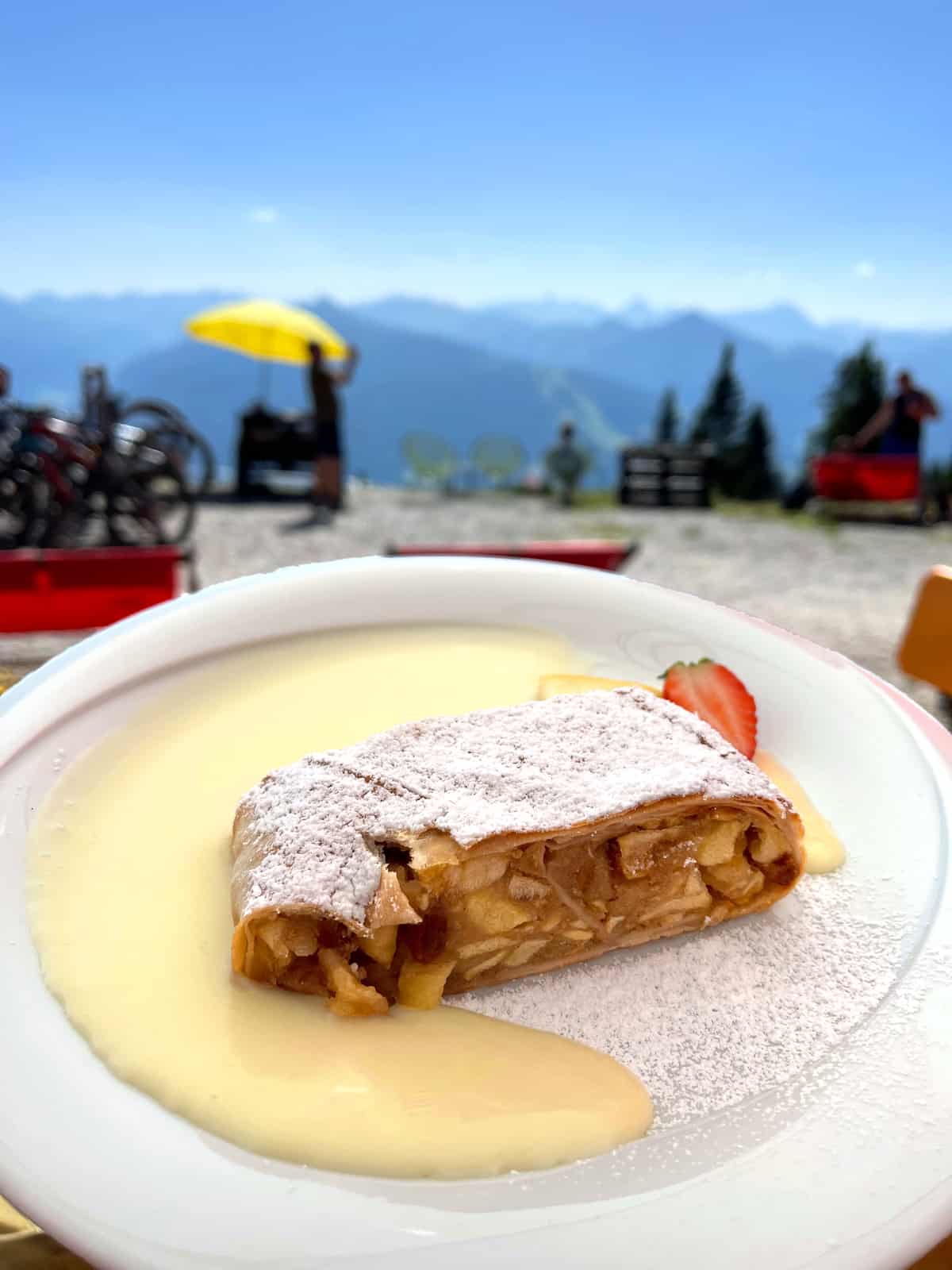
I’m going to share an authentic Apfelstrudel recipe with you that includes all the tips you need to succeed. And don’t get discouraged if you make a mistake in the process and rip the dough – you’re going to roll it all up anyway and shhhh – no one will ever know!
Pro Tips for Making Strudel Dough
Apple strudel dough is rolled and then stretched very thin, to the point of being transparent, so the number one concern for strudel makers is that the dough will rip. Making really thin strudel dough takes patience and practice. Here are a few key points to remember when making strudel dough:
- Be patient. Rome wasn’t built in a day and neither is conquering apple strudel dough. It’s like those pizza chefs you see grabbing a ball of dough, spinning it in the air at the speed of light, and 4.5 seconds later slapping down a perfectly round and beautifully thin pizza crust; it will likely take a few attempts before you get it down. (Though in the case of those pizza dough wizards I’m not sure that even a lifetime of practice will get me there!)
- Make sure your dough has rested adequately so it is soft and pliable, meaning give it a full hour to relax those wheat proteins. And the dough must be at room temperature to work with. If the pastry is too cold, it won’t stretch properly.
- Prepare the apple filling in advance. That thin strudel dough dries out very quickly and that leads to breakage. So have the filling already prepared and ready to go.
Is Strudel Dough Made with Eggs?
Eggs are not included in traditional apple strudel. However, I have seen both Austrian and German recipes that include an egg in the dough and there is a reason for that: adding an egg will make the dough softer and more pliable, and thus a little easier to work with. The tradeoff however is that the finished baked crust won’t be as delicate or flaky. It really comes down to personal preference and if you choose to include an egg no will judge you (at least I won’t).
Can Strudel Dough Be Made In Advance?
Yes. After kneading the dough, roll it into a ball and wrap it tightly with plastic wrap. Store it in the fridge for up to 2 days. When you’re ready to use it, remove it from the fridge and let it rest at room temperature for 90 minutes before using. Depending on the ambient temperature it may need to rest longer so it is soft and elastic.
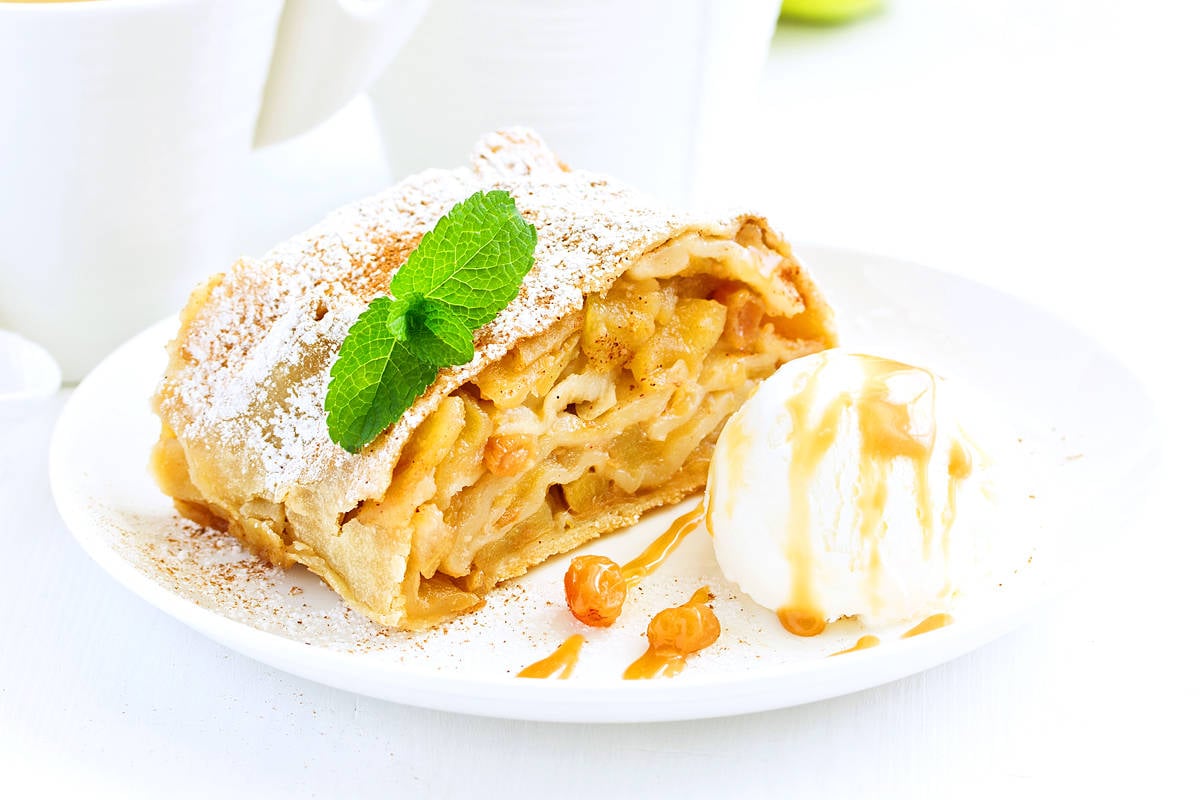
Apple Strudel Recipe
Let’s get started!
Prepare the Apple Filling
For the best flavor I like to toast the breadcrumbs and walnuts. Toast the breadcrumbs in a dry skillet until light golden and then do the same with the chopped walnuts (if using). Drain the rum-soaked raisins and discard any liquid. Combine the sugar and cinnamon. Place the apples, raisins, walnuts, lemon juice, and cinnamon sugar in a large bowl and stir to combine. Set aside.
Note:
- Soaking the raisins in rum is optional but if your raisins are very dry I still recommend soaking them in either apple juice or water to plump them up.
- How much sugar and cinnamon you use is personal preference. Traditional apple strudel is not overly sweet or overly cinnamony; it’s not like typical apple pie filling. How much sugar you use depends on how tart the apples are and the level of your sweet tooth. You can add more sugar if you prefer it sweeter. Likewise you can increase the amount of cinnamon if you prefer.
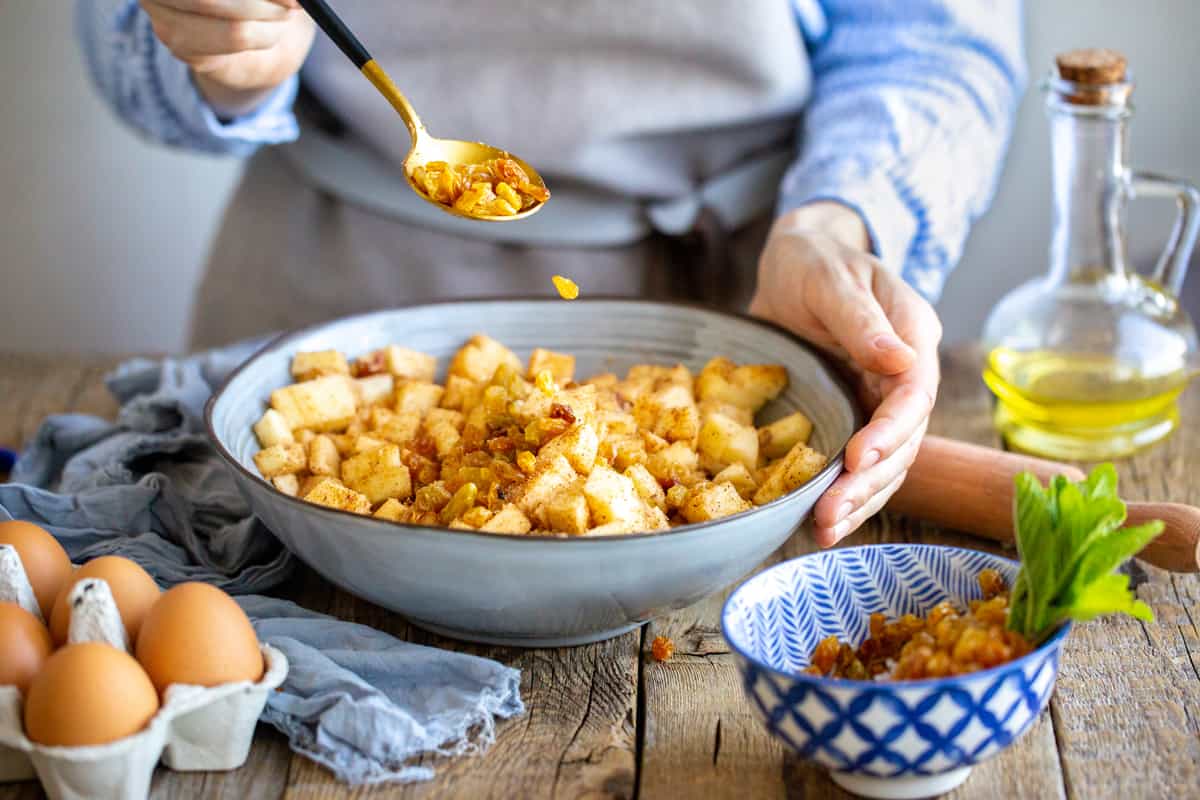
Make the Strudel Dough
In a food processor add the flour and salt, and pulse to combine. Add the water, oil, and lemon juice/vinegar (the acid helps relax the gluten making the pastry dough more elastic) and, if using, the egg. Pulse until the dough comes together. Do not over-knead. Alternatively you can do this in a stand mixer or by hand.
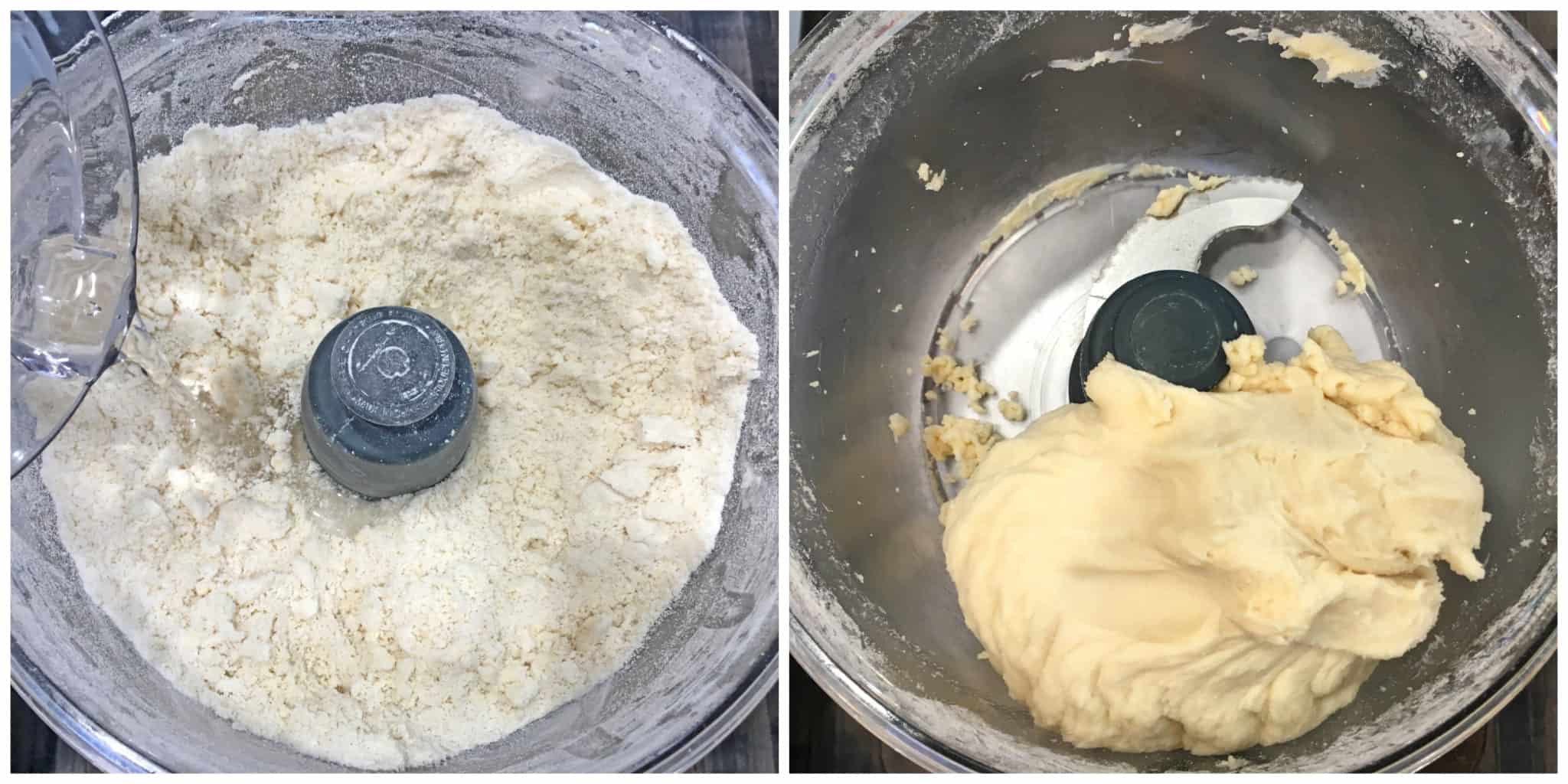
Transfer the dough to a lightly floured work surface, slam it down a few times to encourage the gluten development, and knead for a couple of minutes. If the dough is too sticky add a little more flour. If it is too dry add a little more water. Form the dough into a ball.
Transfer the dough to an oiled bowl, turn the ball around in the bowl to lightly coat the ball in oil, then cover with plastic wrap and let it sit at room temperature for 1 hour. Do not rush this process, the gluten in the flour need time to relax so that it becomes more elastic. The dough is not going to rise during this time since there is no yeast in it, but it’s going to relax and soften.
Note: The strudel dough can be made in advance – roll it into a ball, wrap tightly with plastic wrap, and store in the fridge for up to 2 days. Let it rest at room temperature for 90 minutes before using.
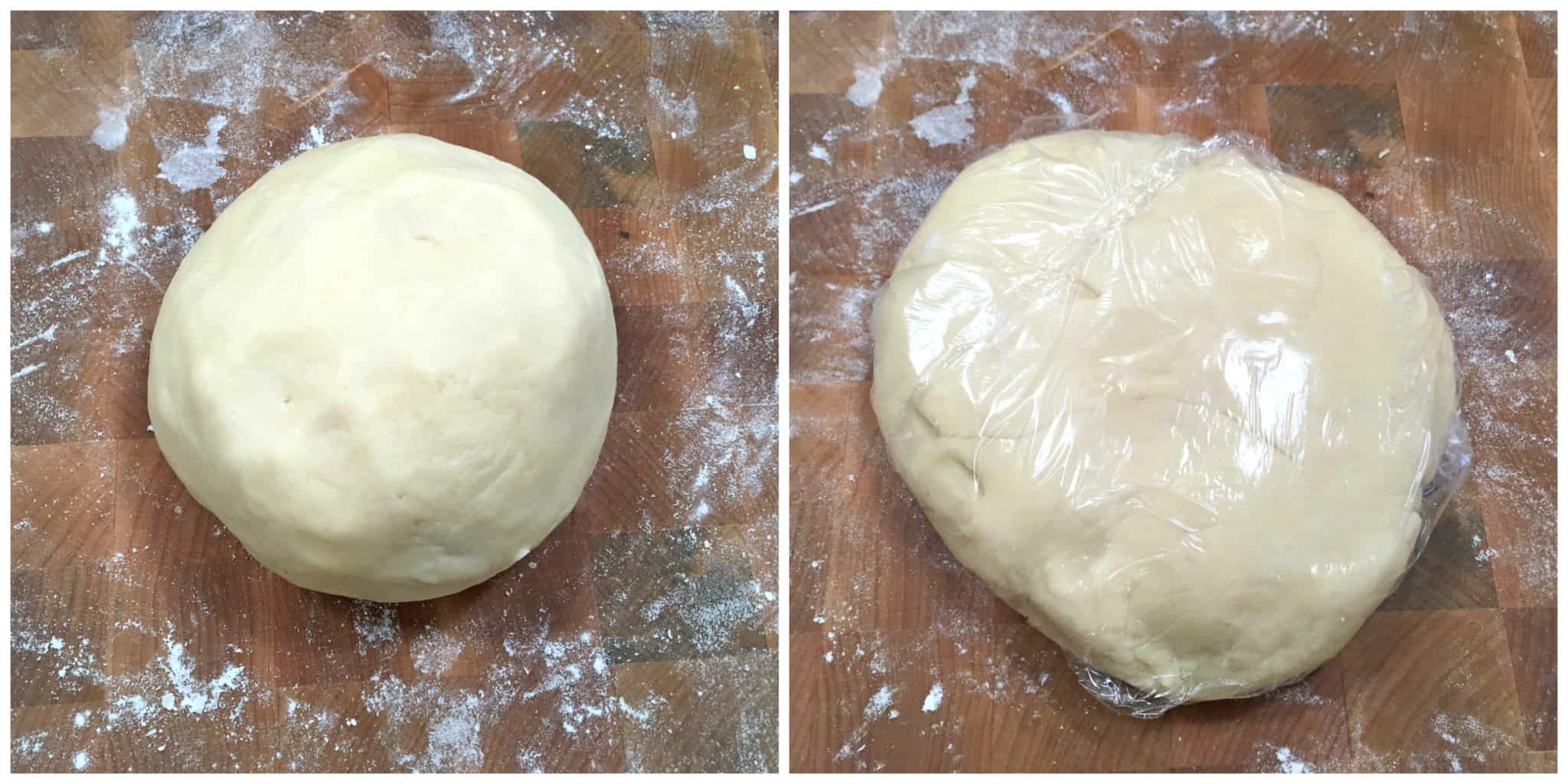
When the dough is done resting, or shortly before, preheat the oven to 375 F (190 C).
Lightly flour a clean work surface and roll the dough out to a diameter of 12-15 inches. On a clean work surface, spread out an extra large, clean, smooth dish towel or a tablecloth and very lightly flour it. Transfer the dough onto the cloth, smoothing any wrinkles in the cloth.
Rub the pastry down with 1/3 of the butter – either rub with very soft butter or brush on with melted butter. This will help moisten the dough to help prevent it from ripping when we stretch it.
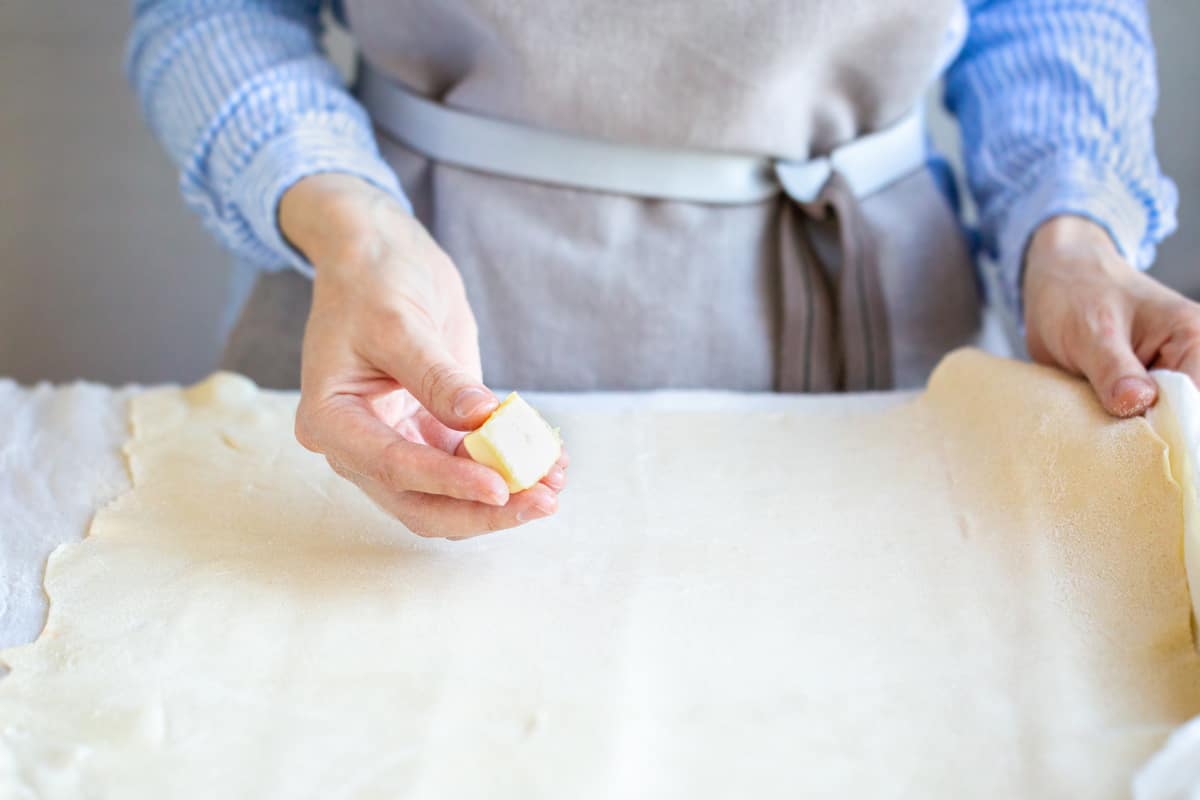
Very gently lift and stretch the dough from the center to the outside, working your way around the perimeter of the dough to form a large rectangular, using your knuckles at first to move from center to the outer perimeter (be sure to remove any jewelry that could get caught on the dough).
Continue this process, gently pulling and stretching any thicker areas of dough. The dough is thin enough when it starts to look translucent and you can see the pattern of the cloth underneath it. The thinner the dough, the flakier the pastry. Trim off the thick band of dough around the pastry sheet, leaving a thin pastry sheet that’s about the size of your standard baking sheet (18×26 in).
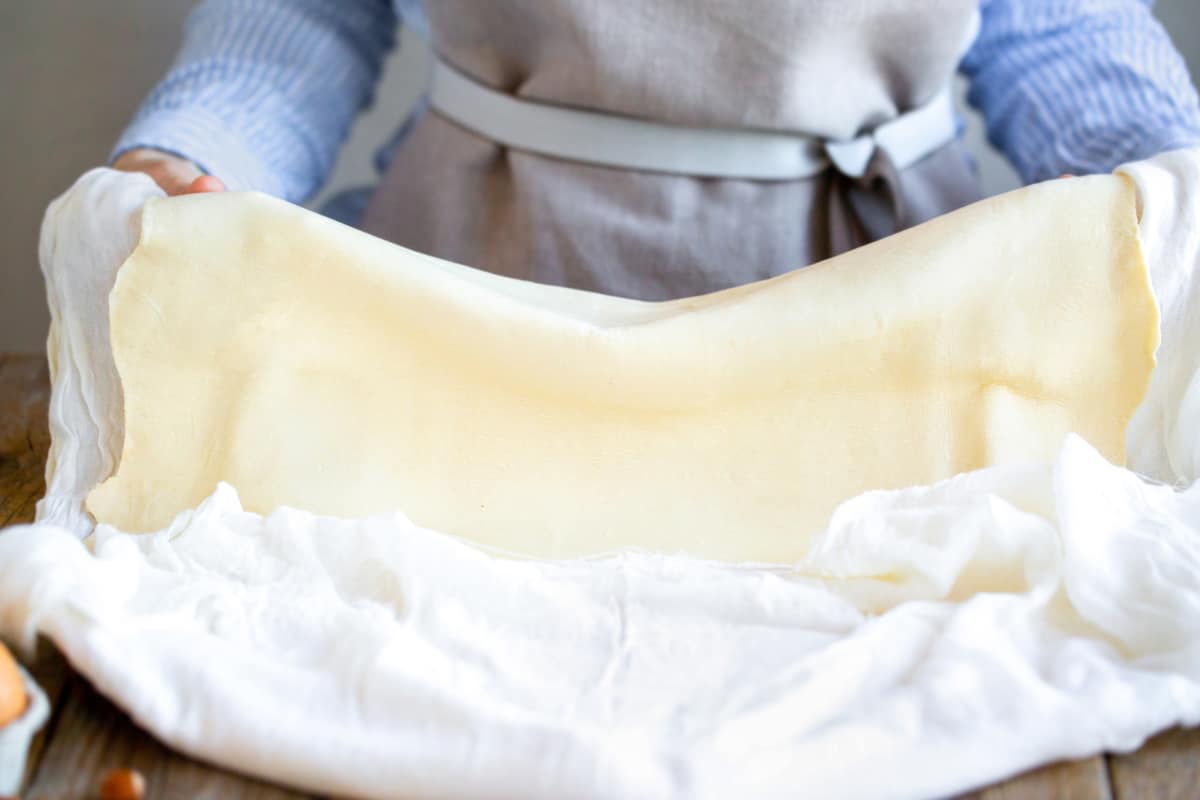
Assemble the Apple Strudel
Brush half of the remaining butter over the pastry sheet. Sprinkle the breadcrumbs over half of the pastry sheet, leaving an inch around the edges. Spread the apple mixture over the breadcrumbs.
Fold in the sides over the apple mixture to prevent it from spilling out, then use the dish towel/tablecloth to lift the end of the roll with the apples, rolling it onto itself all the way to end. Alternatively roll the strudel and then tuck the sides under the roll to prevent the filling from spilling out.
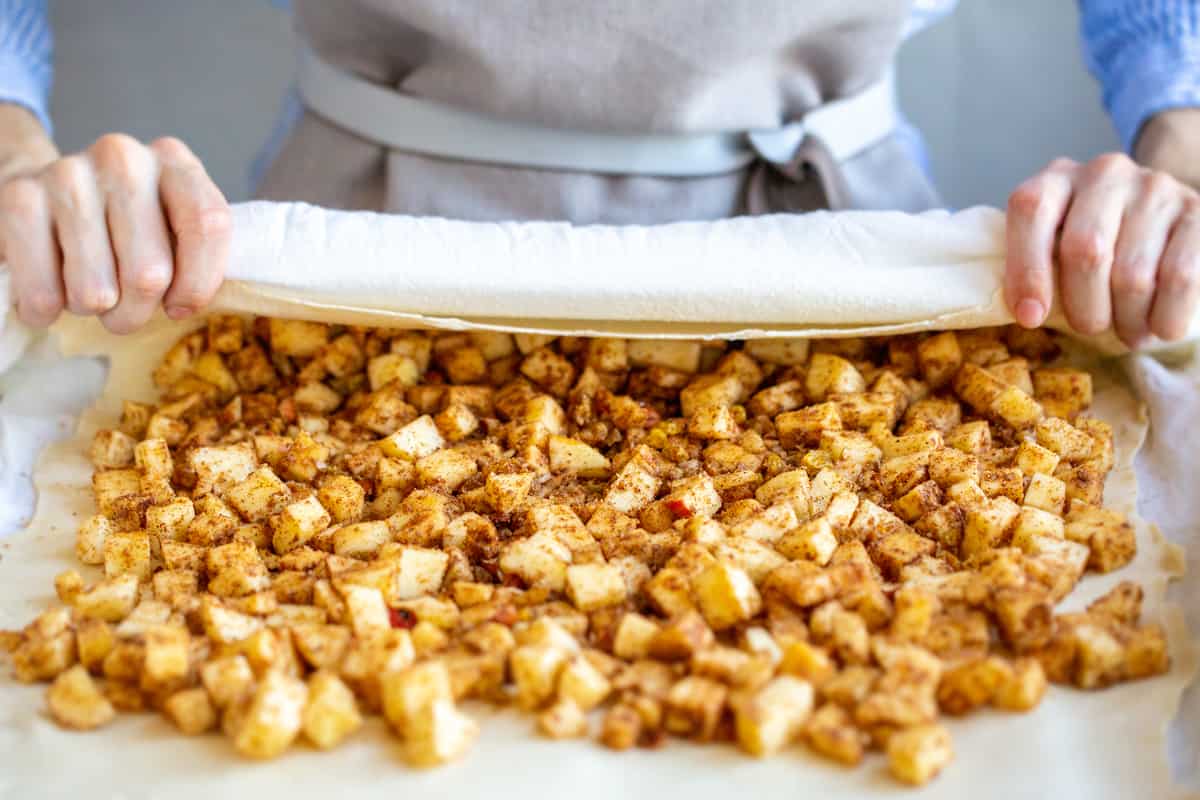
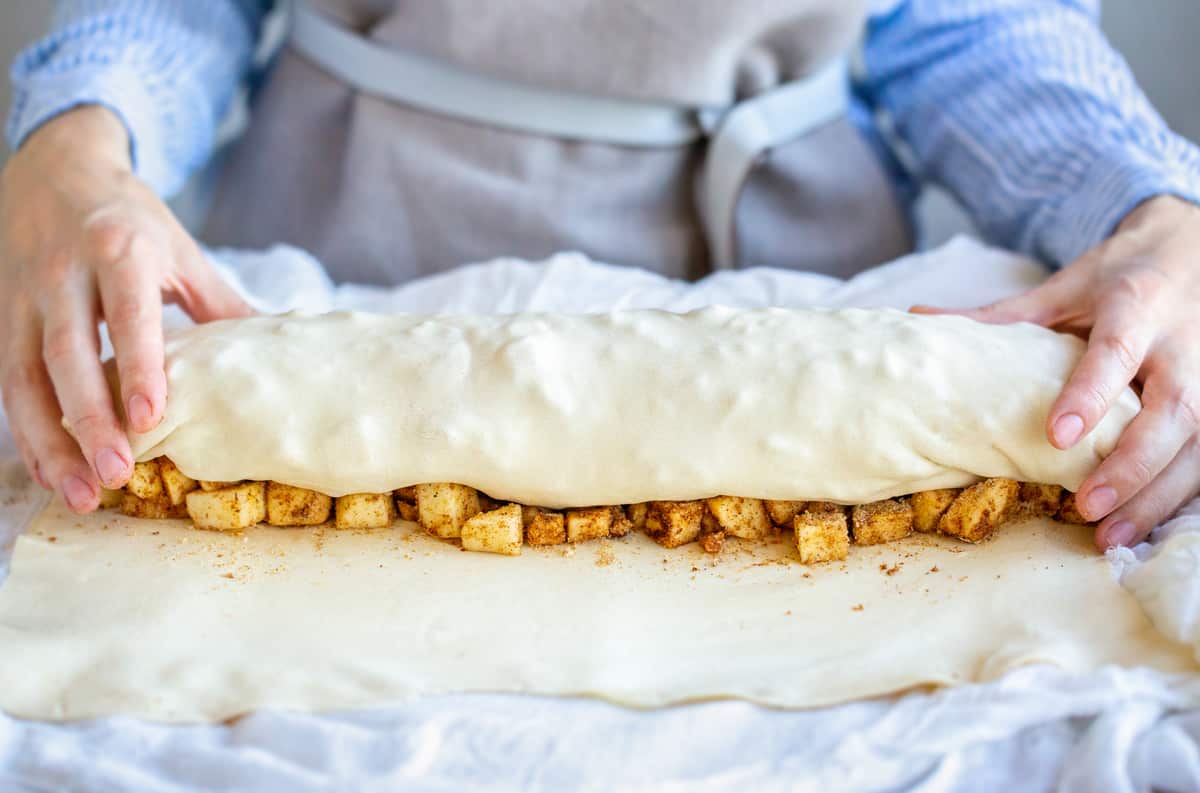
Brush the strudel with the remaining melted butter.
Transfer to a lined baking sheet with the seam side down.

Bake the strudel on the middle rack for 30-40 minutes or until the crust turns a rich golden.
Take the Apfelstrudel out of the oven, let it cool slightly, and then give it a generous dusting of powdered sugar.
Apple strudel is best served straight out of the oven when the crust is still crispy; the crust will soften as it cools.
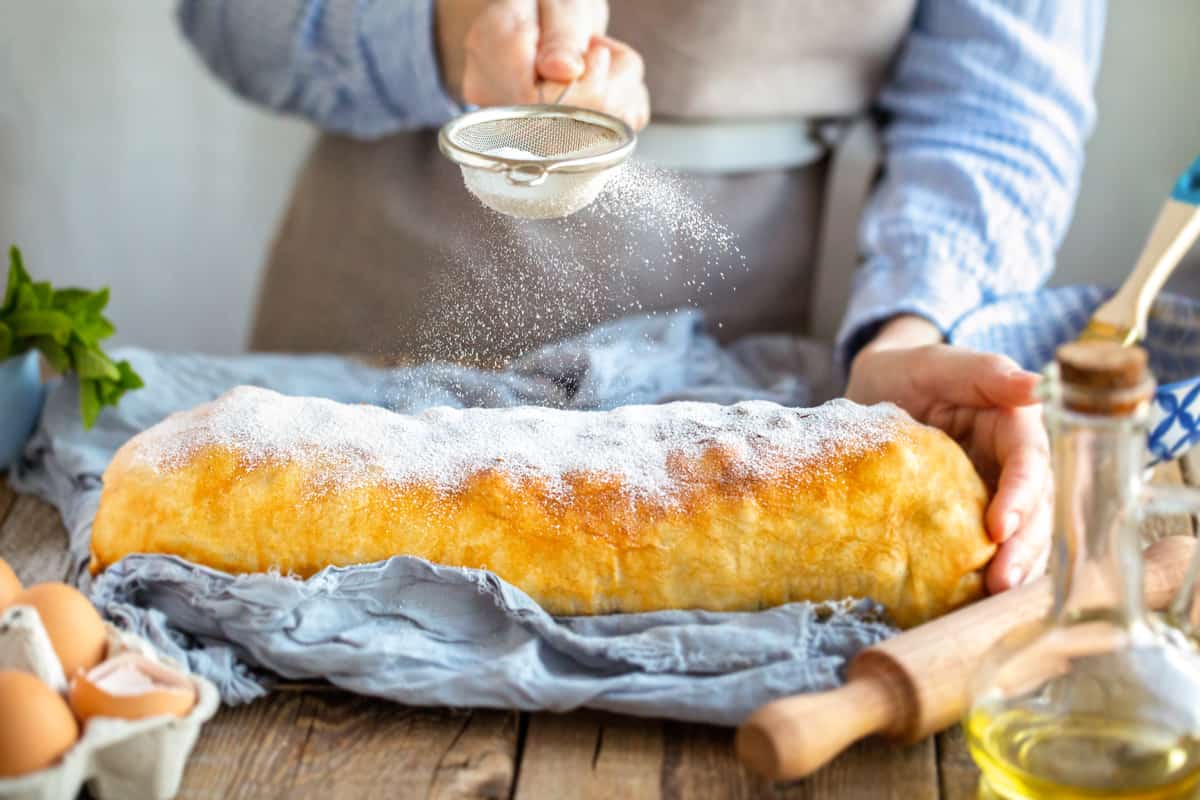
Slice the warm strudel and serve with your choice of vanilla ice cream, or our our homemade Vanilla Sauce.
Enjoy!
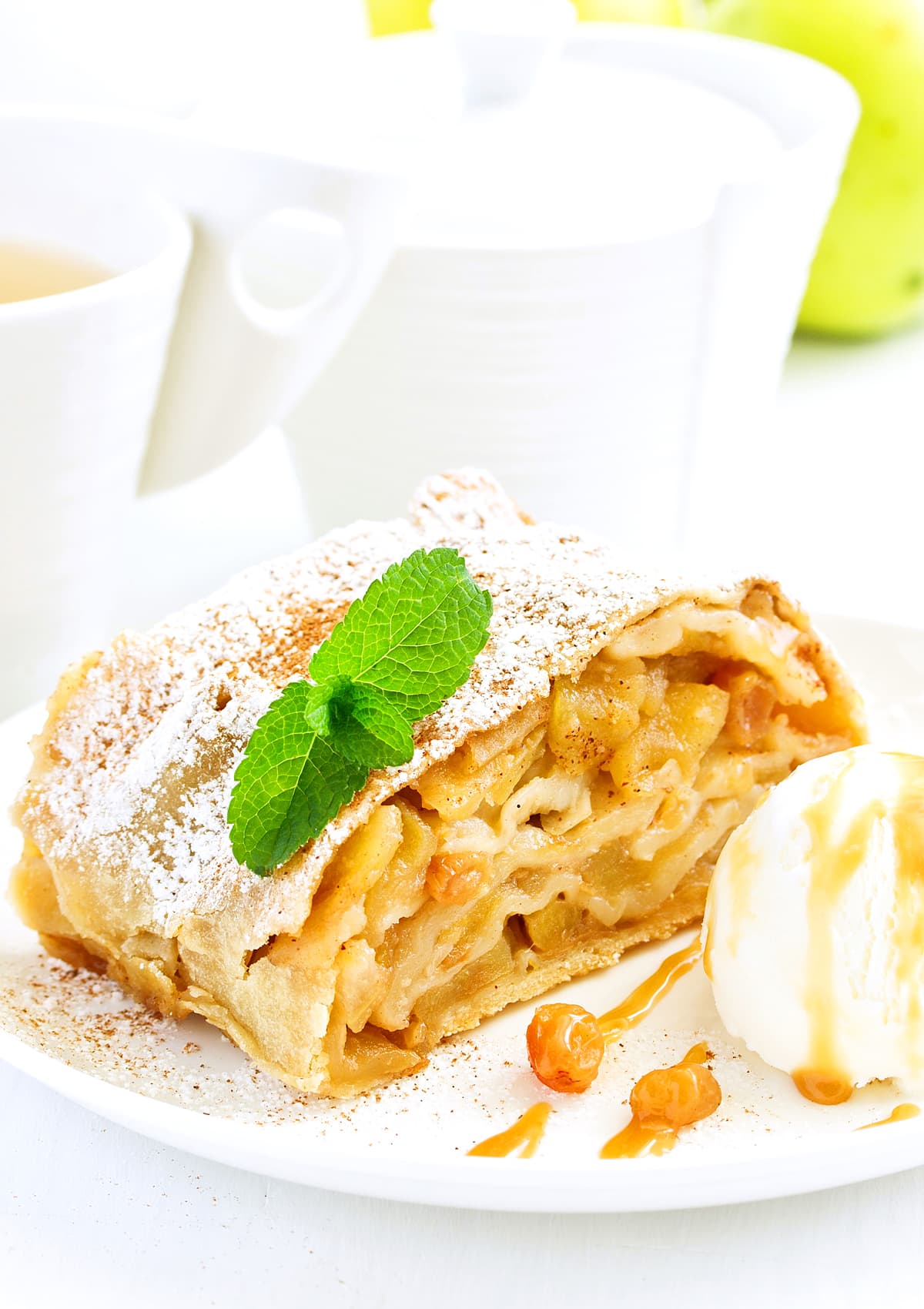
For more delicious Austrian and German desserts be sure to try my:
- Kaiserschmarrn
- Germknödel
- Vanillekipferl
- Mozartkugeln
- Gugelhupf
- German Apple Cake
- German Plum Cake
- Stollen
- Mandelhörnchen
Save This Recipe
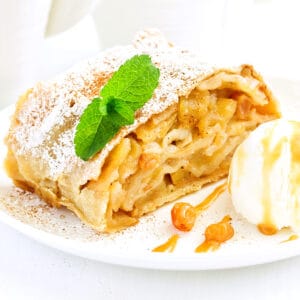
Apple Strudel (Apfelstrudel)
Ingredients
- For the Strudel Dough:
- 2 cups bread flour (can substitute all-purpose flour)
- 1/4 teaspoon salt
- 1/2 cup warm water
- 2 tablespoons neutral tasting oil
- 1 teaspoon lemon juice or vinegar
- 1 egg (optional), makes the dough easier to work with but the pastry will not be as flaky
- 6 tablespoons unsalted butter , melted and divided
- For the Filling:
- 5 medium apples (tart or sweet-tart) , peeled and cored, cut into small cubes or thinly sliced (e.g. Granny Smith, Pink Lady, McIntosh, Braeburn, etc)
- 1/3 cup golden raisins (can use regular raisins)
- 2 tablespoons rum (optional)
- 1/4 cup chopped walnuts (optional), toasted in a dry skillet until lightly browned
- 1 1/2 tablespoons lemon juice
- 1/2 cup granulated sugar
- 1 teaspoon ground cinnamon (apple strudel isn't overly "cinnamony" but you can increase it if you prefer)
- 1/2 cup fine white breadcrumbs , toasted in a dry skillet until light golden
- powdered sugar for dusting
Instructions
- Place the raisins in a bowl and toss with the rum. Let soak for at least an hour or up to overnight. Drain.
- To make the filling:Combine the sugar and cinnamon. Place the apples, raisins, walnuts, lemon juice, and cinnamon sugar in a large bowl and stir to combine. Set aside.
- To make the strudel dough:In a food processor add the flour and salt, and pulse to combine. Add the water, oil, and lemon juice/vinegar (the acid helps relax the gluten making the pastry dough more elastic) and, if using, the egg. Pulse until the dough comes together. Do not over-knead. Alternatively you can do this in a stand mixer or by hand. Transfer the dough to a lightly floured work surface, slam it down a few times to encourage the gluten development, and knead for a couple of minutes. If the dough is too sticky add a little more flour. If it is too dry add a little more water. Form the dough into a ball.Transfer the dough to an oiled bowl, turn the ball around in the bowl to lightly coat the ball in oil, then cover with plastic wrap and let it sit at room temperature for 1 hour. Do not rush this process, the gluten in the flour need time to relax so that it becomes more elastic. The dough is not going to rise during this time since there is no yeast in it, but it's going to relax and soften.
- Preheat the oven to 375 F(190 C). Line a baking sheet.Lightly flour a clean work surface and roll the dough out to a diameter of 12-15 inches. On a clean work surface, spread out an extra large, clean, smooth dish towel or a tablecloth and very lightly flour it. Transfer the dough onto the cloth, smoothing any wrinkles in the cloth, and brush with 1/3 of the butter (this will help moisten the dough to help prevent it from ripping when we stretch it).Very gently lift and stretch the dough from the center to the outside, working your way around the perimeter of the dough to form a large rectangular, using your knuckles at first to move from center to the outer perimeter (be sure to remove any jewelry that could get caught on the dough).Continue this process, gently pulling and stretching any thicker areas of dough. The dough is thin enough when it starts to look translucent and you can see the pattern of the cloth underneath it. The thinner the dough, the flakier the pastry. Trim off the thick band of dough around the pastry sheet, leaving a thin pastry sheet that's about the size of your standard baking sheet (18×26 in).
- Brush half of the remaining butter over the pastry sheet. Sprinkle the breadcrumbs over half of the pastry sheet, leaving an inch around the edges. Spread the apple mixture over the breadcrumbs.Fold in the sides over the apple mixture to prevent it from spilling out, then use the dish towel/tablecloth to lift the end of the roll with the apples, rolling it onto itself all the way to end. Alternatively roll the strudel and then tuck the sides under the roll to prevent the filling from spilling out.Transfer the strudel to a lined baking sheet with the seam side down and brush with the remaining melted butter.Bake the strudel on the middle rack for 30-40 minutes or until the crust turns a rich golden. Remove the apfelstrudel from the oven, let it cool slightly, and then give it a generous dusting of powdered sugar. Serve immediately while the crust is still crispy (it will soften as the strudel cools). Slice the warm strudel and serve with your choice of vanilla ice cream, or vanilla sauce.



















Can I substitute the rum for rum essence? If so, how much should I use?
Hi Mel, yes you can. The rum flavor should be very subtle and not overpower – I’d use about 1/2 teaspoon of rum essence.
I’am confused about rolling the dough. You put breadcrumbs on half with apples on top, so is the other half just put over the top with nothing on it?
Hi Tony, yes, you’re going to roll the filled side towards the unfilled side to ensure you have some pastry dough to wrap around it to seal it all in.
Would I be able to use cherries to make a cherry strudel?
Hi Chris, yes you can but because cherries have quite a bit more liquid in them than apples they require additional thickening. I would consult some cherry strudel recipes and note that they call for cornstarch.
Just like we had in Salzburg! Only your vanilla sauce is even better :) My husband and I prepared this together for date night and relived our trip to Austria together with each and every bite. It made for a wonderful and delicious evening, thank you Kimberly.
Oh that makes me very happy, Rhea, thank you so much! <3
I have always been way to intimidated to try making apple strudel but I’ve had success with every one of your recipes so I thought I’d finally take courage and give it a try. It was DELICIOUS! I also made your vanilla sauce to serve with it. My husband couldn’t stop raving and said it was better than what he had when we visited Vienna, lol :) Thank you, Kimberly!
Oh I’m so happy you decided to give it a go, Lorena, and am beyond thrilled that it was a success! Congratulations and thank you so much for the feedback!
I’ve been on an apple kick and made this and your German apple cake all in the same week :) And no, it isn’t all just for me, I have family in town visiting :) Both of the recipes were truly excellent but I would expect nothing less from you <3
Thank you, Bea, I’m so glad you made and enjoyed both! Have a wonderful visit with your family!
I am so pleased with how this turned out! It was a labor of love but it both looked and tasted wonderful! Thank you for this recipe and the detailed instructions!
Oh I’m so glad it was a success and that you enjoyed it! Thank you, Carly!
Well it wasn’t quite as pretty as yours, but it tasted delicious! The pastry was nice and flaky and the filling was a lovely balance of sweet and tart with just the right amount of spices. It was worth the effort and I will continue practicing on the appearance, lol.
Lol, appearance is overrated, the FLAVOR is what counts most! :) I’m thrilled that you enjoyed it, Suzanne, thank you so much!
I’ve tried many of your recipes and all of them have been wonderful. So I knew even before I started making this apple strudel that it was going to be good. And was it ever! The texture of the pastry was flaky and the flavor of the filling was heavenly. THANK YOU for yet another delicious recipe!
Oh that’s so wonderful, Cathy, I’m beyond thrilled to hear that and appreciate your kind feedback, thank you! <3
Positively the best apple strudel I have had. Made the recipe as written. Thank you for the clear instructions and tutorial. I’ve bookmarked this page and will be making this again. Thank you.
Thank you so much, Terri, I’m absolutely thrilled to hear that!
I use PEPPERIDGE FARM Puff Pastry Sheets.
For a quick version that certainly works, Friedel!
That sounds good but it’s not strudel..and pepperidge farm doesn’t use butter in their pastry, you’d be better off using dufour brand…or try making it the traditional method..its fun!
Last year I made black forest cake, (Oktoberfest party) and while everyone enjoyed it, it didn’t seem worth the effort..however this looks amazing, and similar to how I waa taught by a chef at a restaurant I cooked at years ago…is there any way to make this the day before and keep refrigerated?.Your photos are stunning..what a beautiful country! Stunning!
Thank you, Susie, Austria is very photogenic :) Making strudel in advance is tricky. You don’t want to leave it assembled and unbaked because leaving fruit in an unbaked pastry case is going to make it very soggy. If you’re going to make it in advance I recommend baking it first and then I’d reheat it in the oven to try and get some of the crispiness back.